This article was originally published by Project Sinopsis and has been reposted with permission.
Lennon and the Leninists: Prague’s Lennon Wall repurposed to celebrate the founding of the PRC
The battle for Lennon walls spreads from Hong Kong to the original in Prague.
The Lennon Wall has become a symbol of democracy and freedom not only in the Czech Republic, where it originated, but also in Hong Kong, where replicas have been created during the 2019 protests. On the eve of the PRC’s National Day (国庆节) a group of Chinese “patriots” took over and repainted slogans calling for free Hong Kong turned into graffiti celebrating the 70 years since the CCP won the civil war.
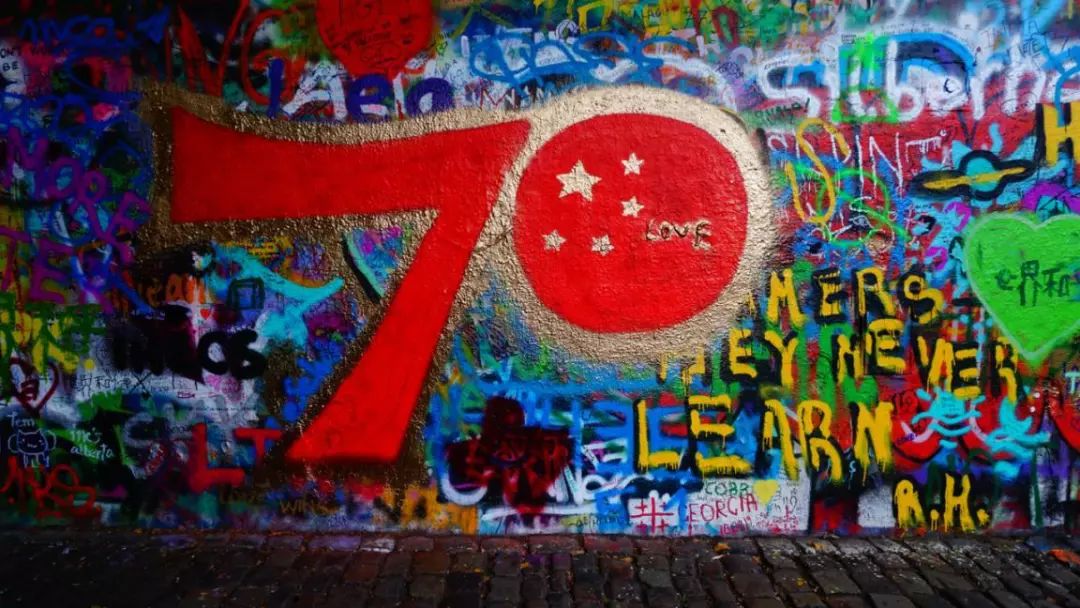
A worldwide symbol of freedom and democracy
The history of a protest wall on Prague’s Kampa Island goes back to the 1960s, but it only became famous after John Lennon died in 1980. The brick wall (which currently belongs to the Order of Malta) immediately filled with texts and pictures commemorating the famous British singer, whose ballads about love and peace managed to climb over the Iron Curtain. The Communist Party of Czechoslovakia tried several times to paint the wall over, but it was unable to stop the increasinly political art from appearing.
In 2014 the concept of a Lennon wall became international as the Umbrella Movement made it its own using colorful Post-it notes to create a mosaic full of complaints and political statements.
This year’s protests saw the Hong Kong “wall” rebuilt, but on top of that, dozens of others started appearing, even in areas that many locals believed to be “pro-Beijing”. There have been shouting matches and violence at the Lennon walls, including a knife attack. Largely immigrants from Mainland China have been actively taking the walls down, sometimes even under police protection.
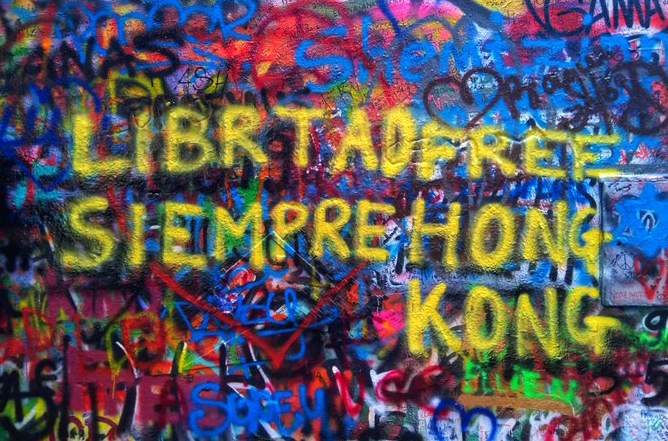
The Lennon Wall has become a symbol of this year’s Hong Kong protests (the artist Badiucao even turned it into a flag now often seen in Hong Kong streets) and its Hong Kong style spread to other countries — e.g. New Zealand, Canada or Australia. The colorful politically-loaded mosaics mostly sprout on university campuses with large number of students from Hong Kong and Mainland China. The walls are often sites of quite violent clashes, especially in Australia, and pro-Beijing groups regularly vandalize them. The PRC government has not refrained from showing support for the “patriotic behavior” of those attacking pro-Hong Kong protesters, as the Consulate-General in Brisbane explicitly described it.
Yet 30 years ago, it was the Chinese students at universities abroad who organized pro-democratic protests in 1989 and promoted the idea that only political freedoms can guarantee true social justice. However, the CCP has learned from its “mistakes.” As the Australian sinologist Gerry Groot puts it:
In the thirty years since Tian’anmen, many once-radical CCP critics abroad have made their peace with the Party and are very sympathetic to Xi’s vision of national rejuvenation. Moreover, the developing trade war with the United States under President Trump plays well to common Chinese notions of national victimhood and humiliation at the hands of foreign powers. The so-called “Hundred years of national humiliation” (百年国耻) narrative, long popular among some intellectuals, was developed into a full-blown “patriotic education campaign” (爱国主义教育运动) in the wake of Tian’anmen and is now the CCP’s longest running and arguably most successful political campaign ever. This campaign helps account for CCP support amongst the Chinese Diaspora(s)… The great wave of Chinese students who went abroad from the 1990s onwards have also by and large been successfully ‘inoculated’ against liberal values.
As part of the campaign, Chinese student associations have come under control of embassies and consulates, and these groups are now under scrutiny, from Australia to Germany and Canada.

Global censorship for world peace
The Hong Kong protests have also left their mark on the original Prague Lennon Wall. Throughout the summer, posts and grafitti in English and Cantonese or Chinese have been popping up, calling for solidarity with Hong Kong and urging the Hong Kong government to comply with the Five Appeals. For several months — at least according to available information — the Lennon Wall has been left without any notice by the Chinese “patriots.” Now that has changed.
According to a local tour guide, an unknown group made two Hong Kong-style Post-it “walls” on the original one in Prague on September 29. Hours later, another group took down the Post-it notes with Hong Kong references and painted a big red-and-gold number 70 that had the PRC flag inside the big zero. Next to the 70, “CHINA” was spray-painted in big letters. All of this happened as the group filmed and shouted “We love China.”
The creator of the “artwork” is Liao Xin 廖鑫, a designer and owner of Beijing Liao Xin Culture and Art Co., Ltd. (北京廖鑫文化艺术有限公司创始人) who posted the feat on Weibo.
A post on the WeChat account “Czech Breaking News” (捷克快讯) titled “I cannot be separated from my ancestral land even for a moment!” interviewed Liao, who explained his motivations:
As working in art design, I want to create beautiful things for the world, not trash. The Lennon Wall is a wall where art lovers express their feelings and that brings true esthetic beauty to the city. It is not a place for political noise. We support freedom of expression and artistic freedom, but we will not allow any person or organization to damage world peace using so-called art, or any opinions that damage world peace or so-called “artistic freedom” to become tools of political deception. The main goal of our graffiti is to wish our ancestral country a happy 70th birthday from Prague, on behalf of the Chinese diaspora. We also hope that through this piece of art we will show the world that China loves peace and that overseas Chinese are of one mind.
A Czech-based blogger offers another account of the event (“The ancestral land celebrates its 70th anniversary; in the Czech Republic, we give it a shout-out” [打call]), described as organized by a group of local ethnic Chinese, in addition to Liao. The author, who having “grown up in Prague” is “no less a patriot than anyone else,” describes how after the “artwork” was done, a group of Czech bystanders applauded and Chinese tourists started streaming in. But soon after this, a group of “Hong Kong separatists” recklesslesly wrote over Liao’s piece using words that “[call for] throwing Hong Kong into chaos,” which has shaken the feelings of local Chinese diaspora: “Both local overseas Chinese and [Chinese] student organizations stated that they would get rid of the poison as soon as possible, and so that very night they went to buy a spray can and painted over the signs.” The Chinese did also get into conflict with “local anti-Chinese elements” and so decided to hold a vigil at the wall waiting for the arrival of another group to paint the wall with even more words and symbols.
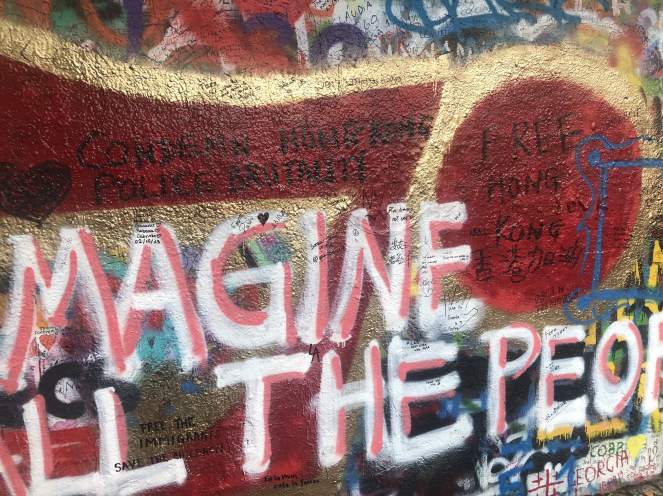
By “poison” they probably mean the “FREE HK” that was painted several times over the number 70 and turned “CHINA” to “ANTI-CHINAZI.” Chinazi has now become a popular term (more about the word in a Language Log post by Victor Mair) to refer to the PRC in the Hong Kong protest movement. “FREE HK” was in turn painted over with red spray-paint, while “ZI” was turned into a star. More posts saying “CHINA” appeared on the wall on October 1. But, like the other ones, they look more like an attempt to suppress references to Hong Kong than a true celebration of an anniversary of the foundation of a superpower.
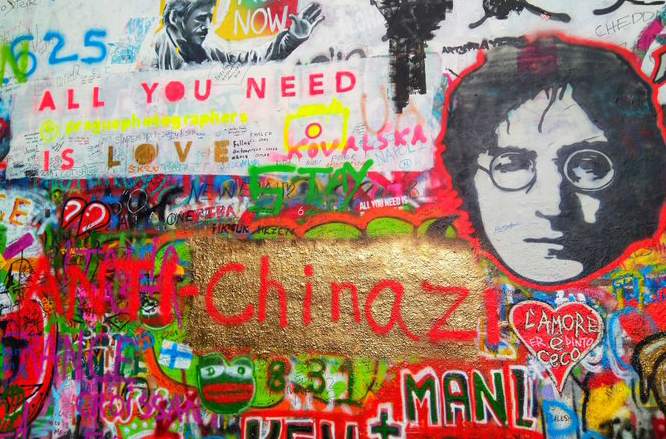
The references to Hong Kong have, however, continued to appear on the wall, while news of the patriotic artwork spread on social media. The incident was described in Czech on Sinopsis, in Czech and English by the author on Twitter, and became a topic of discussion on LIHKG (连登), a forum popular among Hong Kong protesters. Comments there overwhelmingly deplore the “patriotic” graffiti, and even in Mainland China some social-media users have found the act inappropriate, as seen in China Digital Times Chinese-language coverage.
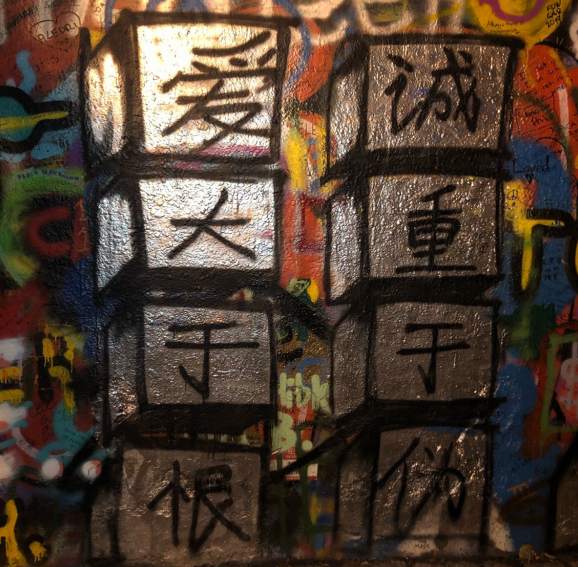
Jichang Lulu contributed research. Thanks to Alex Joske.
Czech version: “Pražská Lennonova zeď slaví 70. výročí založení ČLR,” October 2. Also published on Hlídací pes.







